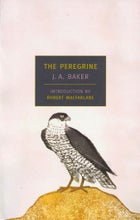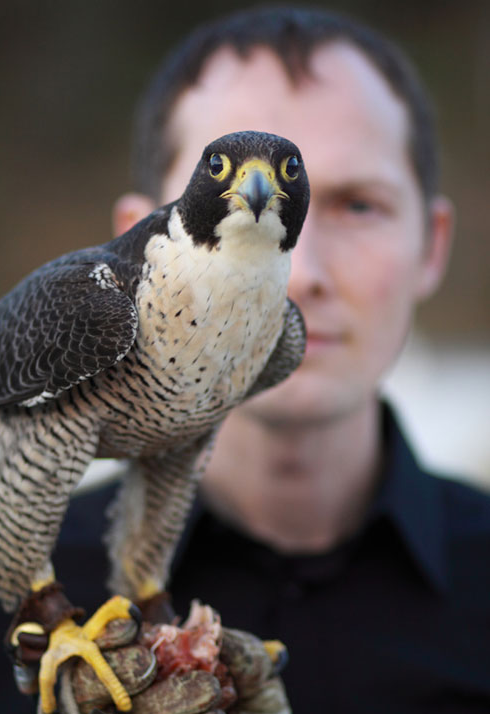by
Buy It
Lawrence EnglishÔÇÖs record, The Peregrine, is out now on . J. A. Baker’s The Peregine can be purchased from .J. A. BakerÔÇÖs The Peregrine
 J. A. BakerÔÇÖs The Peregrine
J. A. BakerÔÇÖs The PeregrineLawrence EnglishÔÇÖs The Peregrine
 Lawrence EnglishÔÇÖs The Peregrine
Lawrence EnglishÔÇÖs The PeregrineJ. A. BakerÔÇÖs The Peregrine is the of nature writingÔÇönot a lot of people have read it, let alone heard of it, yet BakerÔÇÖs molten prose laid the groundwork for numerous travel writers (Barry Lopez, Peter Matthiessen, W. G. Sebald) whose obsession with the natural worldÔÇÖs capacity to reclaim us is, like BakerÔÇÖs, near total. Published in 1967, the book had a simple conceit: from fall to spring, the author would chronicle the comings and goings of two peregrine falcons in East Anglia, on EnglandÔÇÖs eastern coast, near where Baker lived and worked as a librarian. The book takes the form of a diary, but The Peregrine is no birder memoir. As autumn turns to winter, BakerÔÇÖs senses sharpen and his observations become increasingly unhinged as the lines separating his frame of reference from that of his quarry fade and then disappear. Notes Robert Macfarlane in his introduction to the 2004 New York Review Books edition:
“Everything that takes place in The Peregrine takes place within the borders of the peregrinesÔÇÖ hunting ground. The story does not extend beyond this landscape. No cause is specified for the quest itself, no triggering detail. No other human character besides Baker is admitted. We are told nothing of BakerÔÇÖs life outside the field: we do not even know where he sleeps or what he eats. All of this information, we sense, is withheld not to provoke inquiry, but because it is irrelevant. Irrelevant, for The Peregrine is not a book about watching a bird, it is a book about becoming a bird.”
All of which makes BakerÔÇÖs text somewhat odd fodder for an electronic-music homage. Of course, composers have been exploiting soundÔÇÖs potential to evoke nature at least since BeethovenÔÇÖs Pastoral Symphony, and Brian EnoÔÇÖs Ambient 4: On Land, released in 1982 and heavily synthesized, was loosely intended as an audio portrait of BritainÔÇÖs countryside. But, like the book it was based on, Australian composer Lawrence EnglishÔÇÖs The Peregrine, released this month on Ohio label Experimedia, plunges much more deeply into the wild. A single 35-minute piece, it begins as an austere drone (a palate cleanser for the ears) before moving through passages of serene calm, creeping solicitude, and brute violenceÔÇôclosely following the passage of time, the rhythms of the landscape, and the appearance and disappearance of the birds as, high above, they sweep the Essex bush in search of prey. As with BakerÔÇÖs text, the composer seems to recede as sound sheets the landscape like weather. Both Peregrines are that rare document of nature experienced not at the level of the mind or the soul but of the nerve endings. We spoke to English to find out how it came together.
OUTSIDE: Why Baker's Peregrine? Are you a bird enthusiast?
ENGLISH: No book has affected me as strongly. In some ways, I'm not even sure why. I am partial to birdsÔÇösome of my earliest sound experiences involved birds, specifically an Australian species called the . And I've always been interested in raptors. So it's perhaps not surprising that The Peregrine piqued my attention.
How pertinent was BakerÔÇÖs prose to your own writing process?
It was the starting place for so many of the ideas in the piece, right down to the structure, which moves through each of the months he seeks out the birds. But I also used references in BakerÔÇÖs writing to sound and the appearance of the landscape to shape the composition. For example, his descriptions of the density of mist or clouds, of the undulation of the hillside and the qualities of light on surfaces, became like a musical script for me. His writings suggested how I might come at the musicÔÇÖs shape and texture. I looked for and found compositional guides in his words.
And yet the music is totally electronic.
In some ways, the two are the same for me. When we hear a sound from the natural world and it's not something weÔÇÖve experienced firsthand, we use our imagination to create an impression of what might be making it. For example, the first time I heard a was on a recording. I had no idea what I was listening to. I thought it could be a strange mammal or maybe an insect recorded very closely. I created an entirely distinct impression using sound markers from other auditory experiences. The line between natural sound and electronic sound is similarly blurred for me, and IÔÇÖm always interested in accentuating that blur in my pieces.
BakerÔÇÖs account of his seasons with the falcons is pretty immersedÔÇöhe seems to go native. Did you aim for something like that in your work?
You imagine him going native, but at the same time he was an English gentleman living in pastoral countryside, without much space to really go native. What I did try to draw out from his experience was the flow of the seasons. I wanted to create a piece that moved like the book does, creating hints of elements to come. There are passages where winter breaks for a moment, only to return with brutish ferocity. I found those kinds of details very important for the recording. It was designed as a complete journey.
Has your own experience of nature changed?
Baker's descriptions certainly made me think about how the natural world can be viewed. When you read his work, even more so in The Hill of Summer [BakerÔÇÖs second book], he has remarkable eyes and ears. He takes in these vast, sweeping landscapes and still manages to find motion and inspiration in the tiniest bird displays, in anthills, in the movement of light across the tree line. His ability to marry the vast with the intimate really made me consider how natural places can be experienced, and how music might be able to reflect that.


